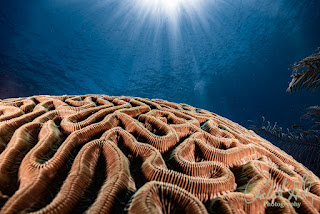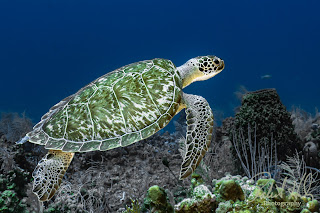Fixing Color Shifts at Depth with Lightroom’s Point Color Tool (v14.4)
Have you ever surfaced from a dive, excited to review your underwater photos, only to be disappointed by the colors? The vibrant, mesmerizing marine world you just experienced can sometimes look dull, washed out, or strangely colored, like purples, cyans, or blotchy greens, that don't do justice to what you saw beneath the waves. If this has happened to you, you're definitely not alone. Many underwater photographers face a common challenge: dealing with unpredictable color shifts caused by factors such as water depth, poor lighting conditions, or the limitations of artificial strobes used to illuminate the scene.
Luckily, new tools in photography software are making a big difference. With the release of Lightroom Classic v14.4, Adobe has introduced an exciting feature called the Point Color Tool. Think of this tool as a precise surgical instrument, more akin to a scalpel than a sledgehammer, providing us with the ability to make targeted color adjustments with incredible accuracy.
Unlike traditional global editing options that affect entire color ranges across the image, the Point Color Tool allows us to select and isolate specific hues based on exact pixel information. For example, if you notice a patch of purple shadow caused by your strobe's reflection or a blotchy red on a coral that didn't come out right, you can now correct just those problematic areas without altering the rest of your beautiful scene.
In this guide, I'll show you how this innovative tool works and how it's revolutionizing the underwater photography experience. Whether you're correcting subtle color casts or removing distracting color patches, the Point Color Tool provides a new level of control and precision, enabling you to bring out the true beauty and vividness of your underwater images.
Let's dive in and explore how mastering this feature can elevate your photography edits, from basic corrections to fine-tuned color perfection.
🧠 Why Point Color Is a
Game-Changer for Underwater Photography
Before version 14.4, adjusting and fixing colors in your photos could often feel like using a blunt tool, effective, but not very precise. Sure, the HSL (Hue, Saturation, Luminance) sliders were available and worked to change colors. Still, they had a significant limitation: they affected every pixel of a particular hue across the entire image. For example, suppose you wanted to correct the red in a gorgonian coral. In that case, you might unintentionally change the skin tone of a diver nearby or even alter the color of a foreground anemone, which was not desirable.
Thankfully, Lightroom introduced a much more precise and user-friendly feature called Point Color. This tool enables you to select a single pixel in your photo using an eyedropper tool and then adjust the hue, saturation, and luminance for that specific color target. This means you can fine-tune the color of that coral without impacting the surrounding water, diver skin, or other objects in the scene.
Even better, Lightroom offers advanced control options with sliders for Hue, Saturation, and Luminance range. These allow you to narrow the scope of your adjustments further, making it easier to target just the colors you want to change and avoid affecting nearby hues. This combination of tools makes color correction more precise, efficient, and less frustrating, empowering you to achieve more natural and vibrant results in your images.
🎯 POINT COLOR TOOL — FILE FORMAT COMPATIBILITY
✅ Works with:
-
RAW (.CR3, .ARW, .NEF, .DNG…)
-
JPEG (.JPG)
-
TIFF (.TIF)
-
HEIC / HEIF (iPhones & mobile devices)
-
PNG (exported edits or graphics)
🧠 Tip for Oceanic Explorers:
Whether you're tweaking a DSLR RAW file or refining a GoPro JPEG between dives, the Point Color Tool provides precise control over hue, saturation, and luminance on any file type.
🛠 How to Access the Point Color Tool
📌 Lightroom Classic v14.4
and Lightroom Mobile 9.4
- Go to
the Develop Module
🔍 Shortcut: D - Scroll
down to the Color Mixer Panel and click Point
Color
- Use
the Eyedropper Tool to select the color you want to fix
- Adjust
the Hue, Saturation, or Luminance manually
🔧 Narrow your selection using the Range Sliders below each - Want
to sample a different area? Just drop a new point!
🐠 Example 1: Cyan Water
Overpowering a Yellowtail Snapper
Problem: At 40 feet, the water has turned
intensely cyan, overwhelming the yellow tones of the fish.
Fix:
- Use
the Eyedropper to sample the cyan water around the fish.
- Drop
the Saturation by -30.
- Adjust
the Hue slider slightly to shift cyan closer to blue
(-10).
- Use
the Hue Range slider to isolate the background water, avoiding any effect on the fish.
🎯 Result: The background
water tones down while the fish's natural color stays untouched.
🐚 Example 2: Purple
Strobe Shadows Behind Coral
Problem: Artificial lighting caused a magenta or
purple cast in the shadows behind coral branches.
Fix:
- Sample
the purple patch using the Point Color Eyedropper.
- Pull
down Saturation (-40), increase Luminance (+25)
to soften the shadow tone.
- Tighten
the Saturation Range to avoid affecting surrounding
blues.
🎯 Result: The purple cast
is gone, and the coral looks natural, with the shadow gently blended in.
🧜♀️ Example 3: Blotchy
Reds in a Nudibranch
Problem: Due to strobe angle or depth, reds on
the nudibranch have turned blotchy or orange-pink.
Fix:
- Eyedrop
a red patch directly on the nudibranch.
- Shift Hue slightly
toward a more natural crimson (+10).
- Boost Saturation by
+15 to give it pop.
- Restrict
the Hue Range to avoid affecting other red corals in the
frame.
🎯 Result: Smooth,
consistent red coloration across the nudibranch, restoring its natural look.
🪸 Example 4: Washed-Out
Greens in Seagrass Beds
Problem: Midwater greens look desaturated due to
depth and blue filtering.
Fix:
- Select
a point on the seagrass leaf.
- Raise Saturation by
+25 and slightly shift Hue toward warmer green (-5).
- Increase Luminance for
brightness (+20).
🎯 Result: Seagrass
appears vibrant and alive, standing out without unnatural glow.
🌅 Example 5: Ambient Reef
Scene with Muted Oranges at Dusk
Problem: Orange sponges and soft corals look
flat and dull due to fading light and camera white balance.
Fix:
- Sample
a muted orange sponge area.
- Boost Saturation by
+30, Luminance by +10.
- Carefully adjust the Hue to transition from pale to richer orange (+5 to +8).
- Use Hue
Range sliders to avoid affecting fire coral or similar hues.
🎯 Result: The reef comes
back to life, showcasing actual reef color even in low ambient light.
🎯 Why This Beats HSL for
Underwater Shooters
Oceanic Explorers, this is where the Point Color Tool truly
shines.
- 🎨
Fix just the problem color—no more accidental global
shifts.
- 💡
Correct blended color issues caused by mixed light
sources (strobe + ambient).
- 🤿
Match natural underwater hues to how you remember the
scene.
⌨ Keyboard Shortcuts Recap (Lightroom Classic 14.4)
|
Action |
Shortcut |
|
Open the Develop Module |
D |
|
Activate Point Color Tool |
Mouse > Color Panel |
|
Reset a Slider |
Double-click slider |
|
Toggle Target Preview |
* (Backslash key) |
|
Toggle Mask Overlay |
O |
|
Zoom to Sample Color |
Z + Click |
💡 Bonus: Combine with
Noise Reduction AI v2.0 for Best Results
To make your colors truly shine, prep the image with AI
Noise Reduction first. This removes grain and blotchiness that often obscures
subtle hues, especially in darker areas or midwater. Check out my full guide on
this at:
📘 Noise Reduction AIv2.0 for Underwater Photos: A Complete Guide to Cleaner, Sharper Results
📌 Final Thoughts:
Precision Brings Life Back to the Deep
Underwater photography is all about bringing back
the colors we remember—those deep reds, vibrant purples, and sun-warmed
oranges that fade with every foot of depth. With Lightroom's Point Color tool,
we finally have a precision instrument that honors our memory and vision
without compromising the rest of our image.
Next time you return from a dive with shots that feel flat
or color-shifted, don't discard them—rescue them. You might be surprised by
what's hiding just beneath the surface, waiting for you to bring it back to
life.
—
Want more Lightroom tools like this one? Subscribe to my
weekly blog at info.robertherb.com/lm-2-blog, or email me directly at bob@robertherb.com for
my latest training dates.
Until next time—
Dive deep. Edit smart. And bring your colors home.
🐠 Ready to Dive Deeper?
Follow my weekly blog at Robert Herb Photography Blog
Share your results using #RobertHerbPhotography
Enroll in my upcoming training series to learn these techniques and more. Email me at bob@robertherb.com
Join the conversation by sharing your edits with #RobertHerbPhotography.
Subscribe for weekly tips at Robert Herb Photography Blog
Questions? Need help refining your Lightroom workflow?
Please send me a message at bob@robertherb.com; I'd be happy to help!
🧭 What's Next?
🟦 Have you tried the new Point Color Tool yet? Share your edits using #RobertHerbPhotography.
🟦 Want to see these workflows in action? Sign up for my upcoming training course at RobertHerb.com or reach out at bob@robertherb.com
🟦 And don't forget—new blogs drop weekly at Robert Herb Photography Blog
Until next time… dive deep, shoot smart, and let Lightroom bring your vision to the surface.
– Bob Herb
Robert Herb Photography
Empowering Underwater Photographers Since 1978
Written by Robert Herb – Empowering underwater photographers to capture and enhance the beauty of our oceans.
Stay tuned for more in-depth insights into underwater photography. Let's dive deeper into the art and craft of capturing the marine world! If you have any comments or suggestions, I'd love to hear them.
Get ready for an exciting underwater photography adventure! For more details on my upcoming online training course, check out my "Training" page at RobertHerb.com or email me at bob@robertherb.com.
Sincerely,
Bob Herb
|
|





Comments
Post a Comment
Please let me know your comments.